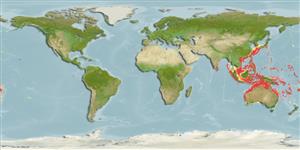Environment: milieu / climate zone / depth range / distribution range
Ekologi
laut dasar (demersal); kisaran kedalaman 4 - 390 m (Ref. 9824). Tropical
Eastern Indian Ocean and Western Pacific: Bay of Bengal to southern Japan, Taiwan, New Caledonia, and several areas of the Indo-Australian Archipelago (Ref. 9824).
Size / Weight / umur
Maturity: Lm ? range ? - ? cm
Max length : 24.0 cm TL jantan/; (Ref. 9824)
Duri punggung (Keseluruhan (total)) : 0; duri punggung lunak (Keseluruhan (total)) : 100 - 114; Duri dubur: 0; Sirip dubur lunak: 78 - 91. Mouth rather small, contained2. to 2.6 times in head length, maxillary extending to below the anterior margin or anterior 1/3 of lower eye. Gill rakers present on upper limb. Caudal fin with 2 simple rays on upper and lower margins. In the male, several anterior dorsal rays somewhat elongated.
Inhabits sandy substrates in coastal bays to deep offshore (Ref. 48637). Feeds on benthic animals.
Life cycle and mating behavior
Maturities | Reproduksi, perkembang biakan | Spawnings | Egg(s) | Fecundities | Larva
Masuda, H., K. Amaoka, C. Araga, T. Uyeno and T. Yoshino, 1984. The fishes of the Japanese Archipelago. Vol. 1. Tokai University Press, Tokyo, Japan. 437 p. (text). (Ref. 559)
Status IUCN Red List (Ref. 130435)
ancaman kepada manusia
Harmless
penggunaan manusia
Perikanan: tidak ada kepentingan
Alat, peralatan
laporan khas
muat turun XML
Sumber internet
Estimates based on models
Preferred temperature (Ref.
123201): 16.4 - 27.8, mean 23.6 °C (based on 607 cells).
Phylogenetic diversity index (Ref.
82804): PD
50 = 0.5000 [Uniqueness, from 0.5 = low to 2.0 = high].
Bayesian length-weight: a=0.00912 (0.00408 - 0.02036), b=3.05 (2.87 - 3.23), in cm total length, based on LWR estimates for this (Sub)family-body shape (Ref.
93245).
Trophic level (Ref.
69278): 3.5 ±0.37 se; based on food items.
Daya lenting (Ref.
120179): sedang, Waktu penggandaan populasi minimum 1.4 - 4.4 tahun (Preliminary K or Fecundity.).
Fishing Vulnerability (Ref.
59153): Low vulnerability (14 of 100).
